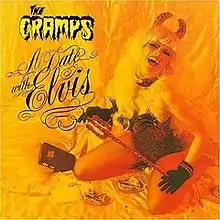A Date with Elvis (The Cramps album)
A Date with Elvis is the third full-length studio album by the American garage punk band the Cramps, released in the UK on Big Beat Records in 1986.[4][5] The title was appropriated from A Date with Elvis (1959), the eighth album by Elvis Presley. The album was recorded in fall 1985 and engineered by Steve McMillan and Mark Ettel at Ocean Way Studios in Hollywood, California. The album was first released in the US in 1990 by Enigma Records, with the bonus tracks "Blue Moon Baby," "Georgia Lee Brown," "Give Me a Woman," and "Get Off the Road." The Cramps reissued the album (with bonus tracks) on their own Vengeance Records in 2001. The original album was reissued in the UK by Big Beat in 2013 on orange vinyl, and subsequently reissued again by Vengeance Records in the US, UK and Canada in 2014. It was The Cramps’ most commercially successful album release, reaching the US Billboard Top 100 and UK Top 40.
| A Date with Elvis | ||||
|---|---|---|---|---|
 | ||||
| Studio album by | ||||
| Released | 1986 | |||
| Recorded | Fall 1985 | |||
| Studio | Ocean Way Studios, Hollywood, California | |||
| Genre | Garage punk, psychobilly, surf rock | |||
| Length | 43:51 | |||
| Label | Big Beat[1] | |||
| Producer | The Cramps | |||
| The Cramps chronology | ||||
| ||||
| Singles from A Date with Elvis | ||||
| ||||
| Review scores | |
|---|---|
| Source | Rating |
| AllMusic | |
| The New Rolling Stone Album Guide | |
The album was dedicated to Ricky Nelson, whose version of the song "Lonesome Town" (covered by the Cramps on their first EP Gravest Hits and later included on compilation album ...Off the Bone) was a US hit single in 1958. It is also significant in that it is the only Cramps album to feature vocals by guitarist Poison Ivy, on "Kizmiaz" (as well as on the B-side "Get Off the Road" included on the 1990 reissue).
Critical reception
Robert Palmer, in The New York Times, praised the album and called it the band's best. He wrote: "After a decade together, the Cramps have learned to focus and intensify their inventive revisions of rock-and-roll tradition and their playfully anarchic spirit."[1] The A to X of Alternative Music called it the band's "most effective distillation of psychedelia, punk and rock'n'roll."[6]
Track listing
All tracks are written by Lux Interior and Poison Ivy Rorschach, except where noted.
| No. | Title | Writer(s) | Length |
|---|---|---|---|
| 1. | "How Far Can Too Far Go?" | 4:10 | |
| 2. | "The Hot Pearl Snatch" | 3:17 | |
| 3. | "People Ain't No Good" | 3:46 | |
| 4. | "What's Inside a Girl?" | 3:22 | |
| 5. | "Can Your Pussy Do the Dog?" | 3:22 | |
| 6. | "Kizmiaz" | 3:01 | |
| 7. | "Cornfed Dames" | 5:26 | |
| 8. | "Chicken" | Traditional; arranged by Interior and Rorschach | 1:40 |
| 9. | "(Hot Pool Of) Womanneed" | 3:09 | |
| 10. | "Aloha from Hell" | 2:35 | |
| 11. | "It's Just That Song" | Charlie Feathers, Ramon Maupin | 2:35 |
| No. | Title | Writer(s) | Length |
|---|---|---|---|
| 12. | "Blue Moon Baby" | Meridan, Rowe, Satalsk | 2:38 |
| 13. | "Georgia Lee Brown" | Hafner, Zinn | 3:24 |
| 14. | "Give Me a Woman" | Willie Jacobs | 2:25 |
| 15. | "Get Off the Road" | H.G. Lewis | 3:12 |
Charts
| Chart (1986) | Peak position |
|---|---|
| Australian (Kent Music Report) | 98[7] |
Personnel
The Cramps
- Lux Interior – vocals
- Poison Ivy Rorschach – guitars, bass, vocals on "Kizmiaz" and "Get Off the Road"
- Nick Knox – drums, bongos
with:
- McMartin Preschool Choir (includes Fur Dixon) – vocals on "People Ain't No Good"
References
- Palmer, Robert (July 30, 1986). "The Pop Life; Evolution of Psychobilly on New Cramps Album" – via NYTimes.com.
- Cleary, David. "The Cramps: A Date with Elvis Review" at AllMusic. Retrieved September 10, 2011.
- Brackett, Nathan; Hoard, Christian David (June 21, 2004). The New Rolling Stone Album Guide. Simon and Schuster. ISBN 9780743201698 – via Google Books.
- "Cramps".
- Guides (Firm), Rough (June 21, 2003). The Rough Guide to Rock. Rough Guides. ISBN 9781858284576 – via Google Books.
- Taylor, Steve (September 27, 2006). The A to X of Alternative Music. A&C Black. ISBN 9780826482174 – via Google Books.
- Kent, David (1993). Australian Chart Book 1970–1992 (illustrated ed.). St Ives, N.S.W.: Australian Chart Book. p. 76. ISBN 0-646-11917-6.